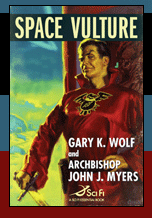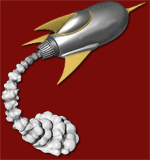 |

|
||||
Steven Silver's ReviewsSpace VultureWhen John J. Myers was a child, he read Anthony Gilmore's novel Space Hawk. He was so enraptured with it, he loaned it to his friend Gary K. Wolf. Both boys were captured by the novel and became life-long fans of science fiction. As the years progressed, both boy grew into men of accomplishment. Myers was named Bishop of Peoria, Illinois and Wolf wrote the novel Who Censored Roger Rabbit?, which was turned into a highly successful movie. And yet, Space Hawk remained in the background, leading the two men to write an homage to the novel, Space Vulture. Space Vulture is filled with pulp goodness. The heroes are all heroic, the villains are all villainous, the cowards are all cowardly, and all of the characters are writ larger than life. On the side of good is Captain Victor Corsaire and the heroine, Cali Russell. Opposing them is the eponymous Space Vulture, and somewhere in the middle is the small-time crook, Gil Terry, who finds himself taking care of Cali's kids when all he really wants to do is reclaim his property, in this case his eye and arm, from the bookies who are holding them until he can repay his debt. In many ways, Space Vulture lacks a plot, instead casting the characters as running around, almost as in a farce. However, this farce has serious consequences for the characters. As noted, Terry simply wants his arm and eye back. Corsaire seek the capture of the villainous Space Vulture, Cali is seeking to be reunited with her children who were left behind when Space Vulture enslaved the entire population of her frontier world, and Space Vulture seeks vengeance on Corsaire and any who aided him in real and imagined slights. Without worrying about the specifics of a plot, Wolf and Myers are able to focus their attention on creating interesting and fun characters. Even the vile Space Vulture and cowardly Terry are enjoyable to read about within the confines of the novel. Making these characters larger than life, practically caricatures, allows the reader to root for them, despite their drawbacks, simply because they aren't real people. At the same time, Wolf and Myers allow their characters to grow. The Victor Corsaire at the end of the novel relates to Cali Russell, her sons, and even Gil Terry, in a manner which would have been inconceivable at the beginning of the book. The character growth allows readers to empathize with their characters despite their caricature nature. Space Vulture is an entertaining romp and a throwback to the age of the pulps, although the authors have shown an understanding that plotting, writing styles, and ideas have changes since "Anthony Gilmore" (really Harry Bates and Desmond W. Hall) published Space Hawk in 1952. Space Vulture successfully captures the sense of wonder that allowed Space Hawk to call itself "the Greatest of Interplanetary Adventurers" while avoiding the traps of trying to recreate a novel that was written more than half a century ago. — Steven H. Silver
|
||||
| The Book | The Story | The Characters | Two Boys | The Authors | The Origin | New Pulp Traditions Articles | Reviews | The Sonic Room | Purchase | Contact Us © 2007-2011 Gary K. Wolf and Archbishop John J. Myers. All rights reserved. Privacy Policy |
